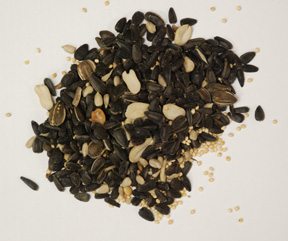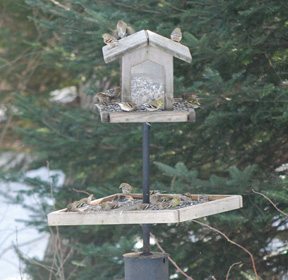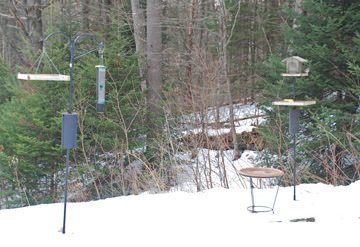Bird watching can be a wonderful pastime all year round, and especially enjoyable when you can bring them to your own backyard. To maximize the variety of birds and to ensure they will keep coming back, we asked Jeannette and Derek Lovitch, the owners of Freeport Wild Bird Supply in Freeport, Maine, for their tips on setting up a habitat to attract birds.
Bird feeding stations can be “as simple or as elaborate as you want,” said Derek, “The more diversity in feeders the more bird varieties you have the chance to attract.” A successful feeding station will offer a variety of food, including seed blends, fruit, meal worms and other bird attractors.
 Jeannette suggested starting with a simple hopper feeder with a good capacity and good sized area for birds to gather. If you’re only planning on one feeder, you’ll want to offer a birdseed mix that provides good nutrition and quality. The Lovitches recommend a blend of 75% black oil sunflower seeds, mixed with millet, hulled sunflowers, safflower and black stripe sunflower seeds.
Jeannette suggested starting with a simple hopper feeder with a good capacity and good sized area for birds to gather. If you’re only planning on one feeder, you’ll want to offer a birdseed mix that provides good nutrition and quality. The Lovitches recommend a blend of 75% black oil sunflower seeds, mixed with millet, hulled sunflowers, safflower and black stripe sunflower seeds.
They don’t recommend birdseeds purchased from large retailers, as they can be full of filler seeds, including the reddish-brown round “milo” seed, which is not consumed by any birds except certain desert species. Discount retailers can also stock old or moldy seed that can cause problems for your birds. Store your seeds in cool dry places in metal or plastic containers.
Interestingly, most birds don’t eat seeds, and so to expand your visitors you’ll want to include oranges and grape jelly to attract some of the more colorful species such as tanagers, and orioles. Quality rendered suet blocks can also expand your visitors. Meal worms either live or freeze-dried will also attract many kinds of birds. No special apparatus for meal worms is necessary, just a dish on the platform feeder. There are meal worm-specific receptacles available.
One color you’ll want to avoid when feeding birds is the red dye often added to hummingbird feeding formulas. According to Derek, this suspected carcinogen, red 40, appears in a single package of hummingbird mix in an amount that exceeds the recommended amount for a human being for a year. In a tiny hummer, that’s an incredibly high dose! Just plain white sugar and water works just fine. To make a simple syrup, combine one part white sugar to four parts water and bring to a boil. Cool the syrup and refresh the feeder every three to five days. That’s all you need for the hummingbird or oriole feeder.
Placement for safety and enjoyment
To avoid the birdseed vacuuming effects of squirrels, place your feeder on a pole at least 10 feet away from any structure or tree that could provide a leaping off point. An inexpensive, properly sized and placed, metal baffle on the pole defeats climbing attempts. You’ll also want to keep your birds away from reflective windows, which kill birds when they mistakenly fly into them. Derek explained there are a couple of ways to reduce fatal bird strikes, including solid or transparent UV color decals, which the birds can see, but don’t block the view for humans.
If you are able to place the feeder further than 30 feet away from your windows —safest distance for avoiding bird strikes—you may want to invest in some binoculars for closer viewing and enjoyment. You don’t necessarily have to buy expensive binoculars, just keep the power to 7x or 8x for best viewing. Stay away from the combo camera and binoculars, the technology isn’t quite there yet.
Field guides add to the fun
Getting to know the birds in you backyard is another facet of bird watching. You can usually pick up a basic field guide for your region to identify most birds you’ll see. If you want to get more serious, and perhaps range beyond the backyard, more extensive bird guides may be the trick. If you’re just starting out, you may want to see if you can find a simple backyard birds brochure to give you the basics. Derek recently published his own eight-page weatherproof Birds of the Maine Backyard brochure, which features the full-color artwork of a local high school bird enthusiast, Luke Seitz. Read more here.
Finally, a note about housekeeping. If you are attracting a lot of birds, one responsibility you don’t want to neglect is keeping the area around your feeding stations raked clean of shells waste and other debris. The waste can host bird diseases and other problems that may affect the health of your wildlife, children and pets. Maintaining a clean feeding area goes a long way to keeping your habitat healthy.

